Former Manchester City assistant manager, Mikel Arteta, became the new Arsenal manager. This was the first time the former Barcelona academy player was appointed as a first-team coach. However, the Spaniard already had experience in coaching in the Premier League, as, in the 2016/17 season, Pep Guardiola authorized a match for Arteta to take care of – it was the City vs Arsenal match at the Etihad Stadium.
In this tactical analysis, we are trying to address two issues mainly. First, how City attacked; second, how they defended. It is an analysis that focuses on Arteta’s tactics.
Lineups
Arteta played his team in a 4-4-1-1 formation. Both Sergio Agüero and Fernandinho were suspended due to red cards in the Chelsea game. Claudio Bravo started in goal. Vincent Kompany was suffering a knee injury, while John Stones was left on the bench. Therefore, Aleksandar Kolarov partnered Nicolás Otamendi at the centre of defence. Raheem Sterling started as a striker.
Arsène Wenger’s Arsenal played in a 4-2-3-1 formation. They had some injuries at that time. Aaron Ramsey and Shkodran Mustafi were suffering from hamstring injuries. Mathieu Debuchy was not fully fit for 90 minutes. Santi Carzola had undergone knee surgery. Danny Welbeck’s problem was cartilage damage. Per Mertesacker had some problems with his knees.
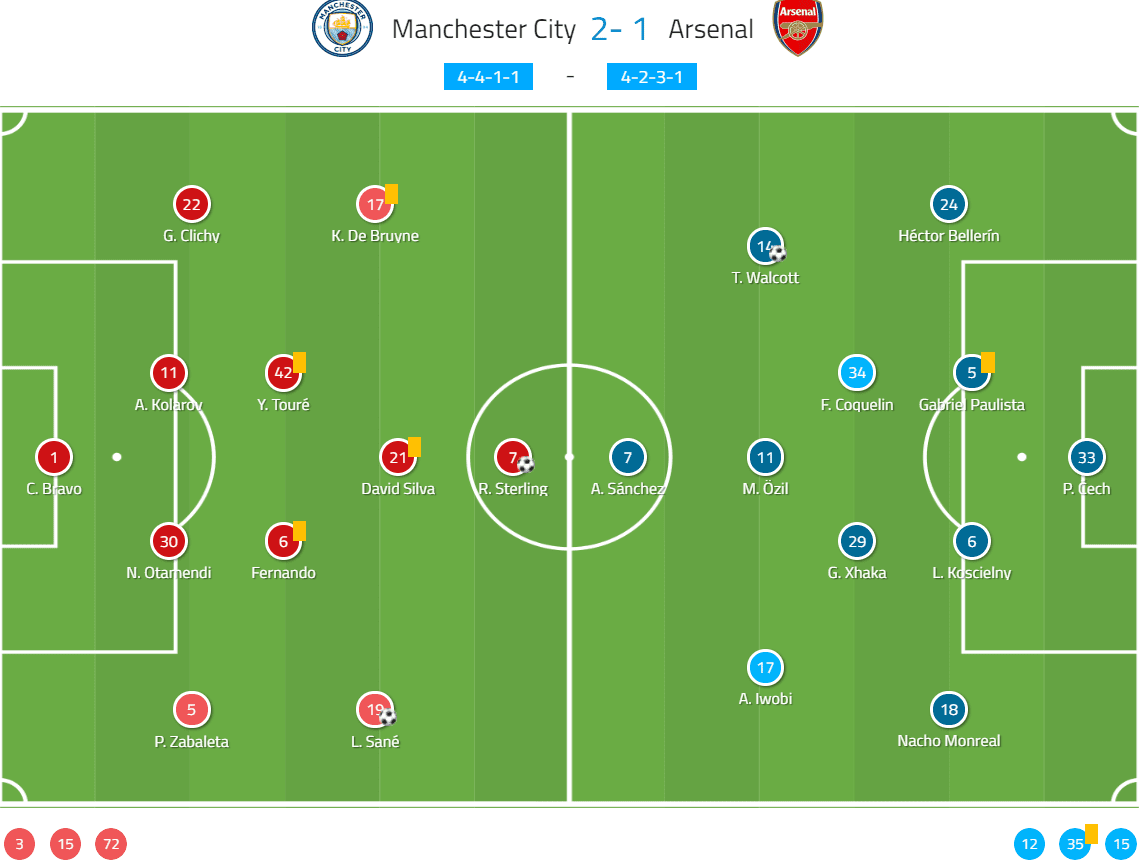
City’s build-up
Usually, City played with a sole holding midfielder, but in this match, their formation contained two. With Fernando and Yaya Touré as the backbone in midfield, Arteta’s team manipulated the positions of Xhaka, which was conducive to their build-up plays.
In general, Arsenal defended with a 4-4-1-1 or 4-5-1, depending on Mesut Özil’s position. Their defensive midfielders were Xhaka and Francis Coquelin and they should have stayed close to each other to deny central penetrations. They failed to do this because of the flexible build-up of City.
With a player occupying Xhaka, dragging the Swish higher on the pitch, City increased the gap between Coquelin and him. In this example, Touré dropped in front of Kolarov without pressure, since Fernando took away Xhaka, and the Ivorian could find Kevin De Bruyne, who was between the lines, with a vertical pass.
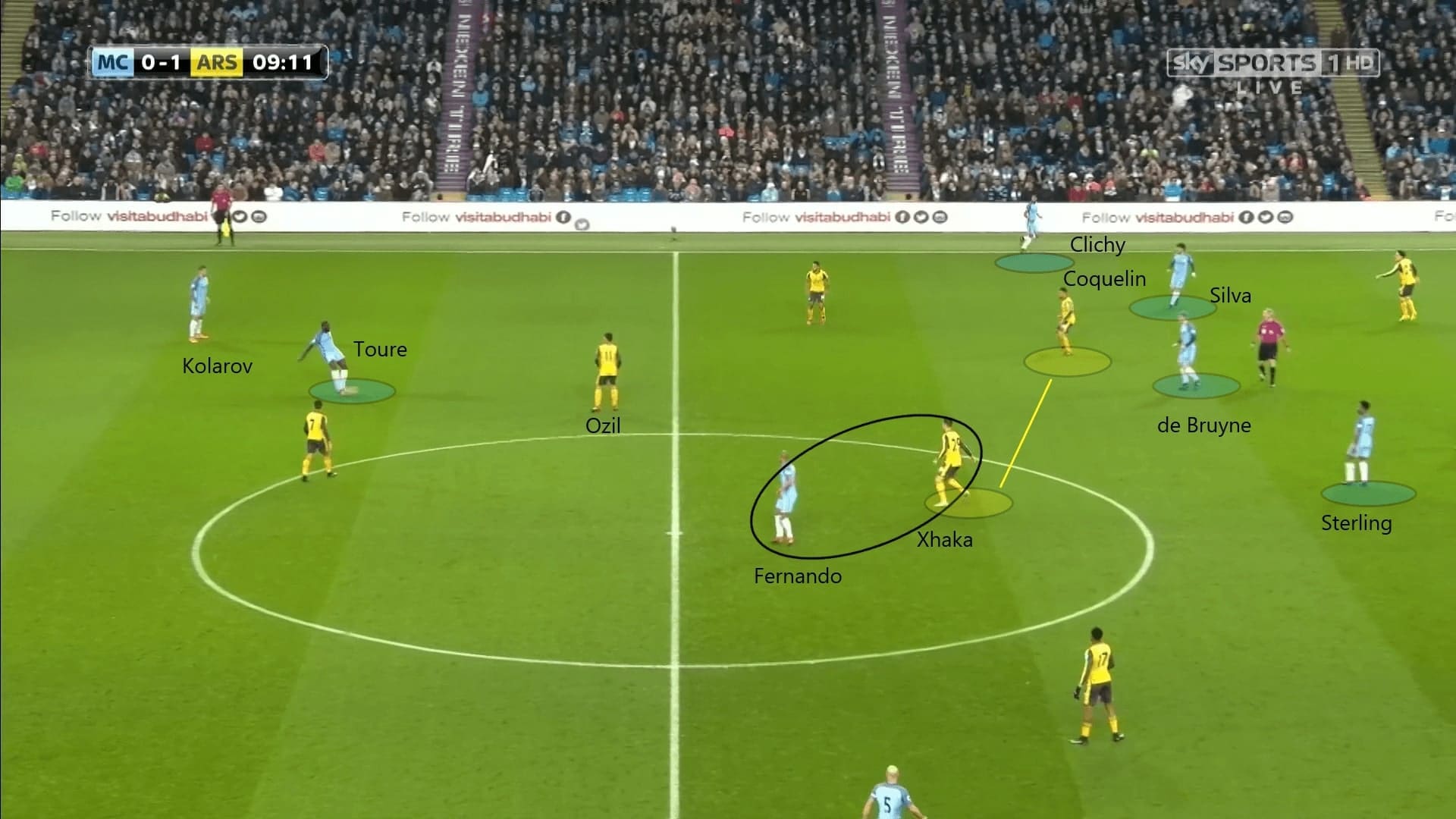
Arteta also wanted to create a better condition for the ball carrier to play the ball. They achieved this by pinning the opposition. Fernando was not the best player to play with the ball when compared to his teammates. Therefore, he was not heavily involved in the build-up, instead, the Brazilian manipulated the positions of the opposition.
In this situation, Özil should have marked Kolarov or put some pressure on him. However, the German was slightly off his position as he was aware of Fernando as well. This time Kolarov did not pass to the players between the lines. Since Arsenal set their defence high, City got plenty of space behind the defenders to exploit. Furthermore, with the left foot of the Serbian, Arteta instructed him to play diagonal balls or go long.
On average, City played long less than 20 times in the first half of the 2016/17 domestic league. Against Arsenal, they played 25 long balls and nine of them were from Kolarov. This pass helped City eliminate the midfielders of Arsenal and entere the final third directly; City players also made forward runs in the match.
We guess among the centre-backs of Arsenal currently, David Luiz could be the most suitable person for this role if Arteta wished a defender to play diagonal balls.
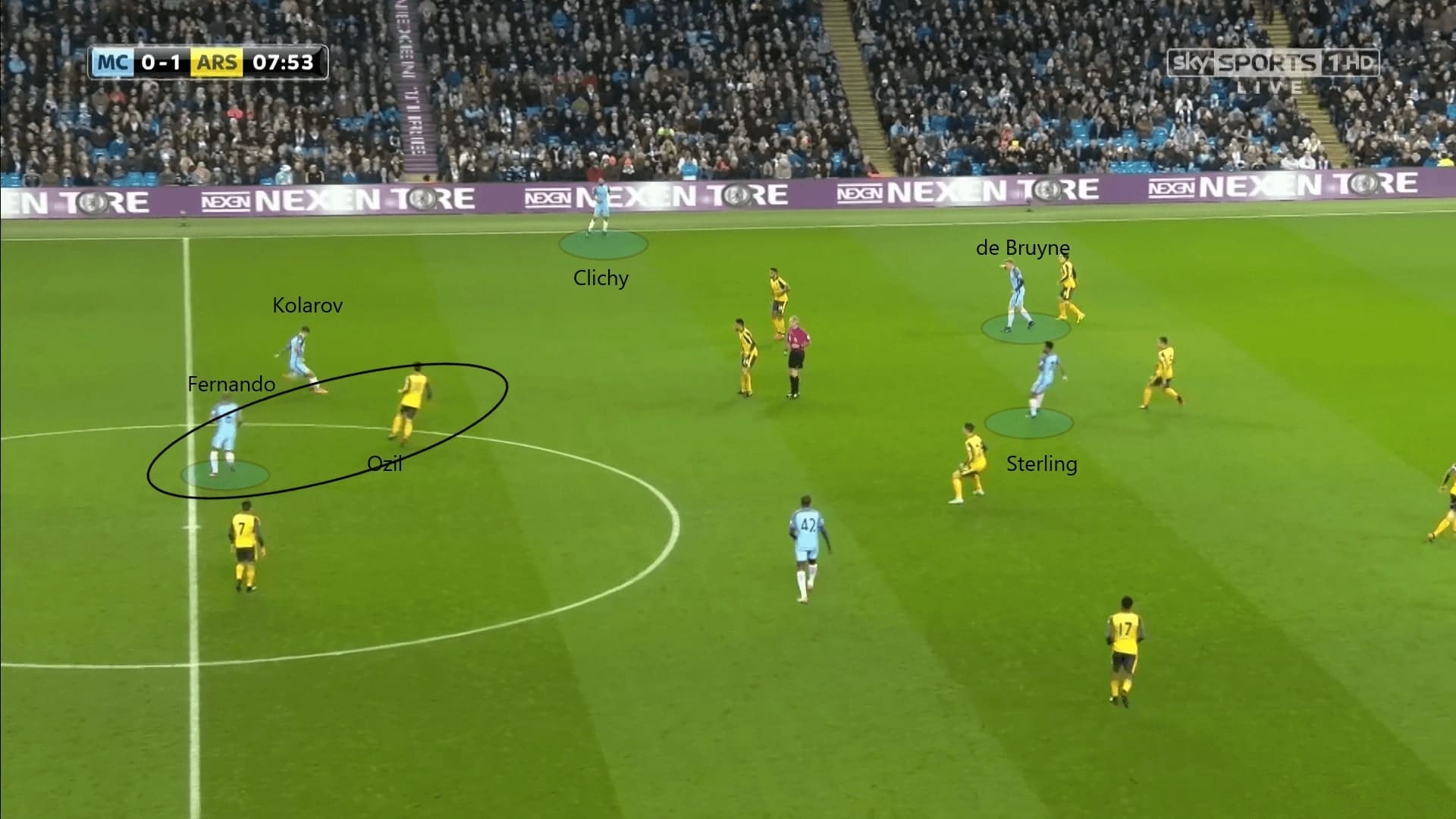
City in the final third
There were two points to note on City in the attacking third. Their formation was like a 4-2-4, depending on the positions of full-backs. In this match, Gaël Clichy provided the width on the left. Their attacking players could roam the pitch. After the break, Arteta made some changes on the general position of players as he moved De Bruyne to striker, placed Leroy Sané on the left and Sterling on the right. These players, along with David Silva, tried to stretch the opposition defence. The central players stayed between the lines. This allowed City to attack with width and layers. On both sides, City had two players to overload a full-back.
On the other hand, City’s defensive midfielders stayed tight to each other. With two players at the centre of the pitch, City reacted better during possession turnovers as their centre-backs did not have come this high.
On this occasion, City could not beat the deep block of Arsenal since their wingers were staying in their positions.
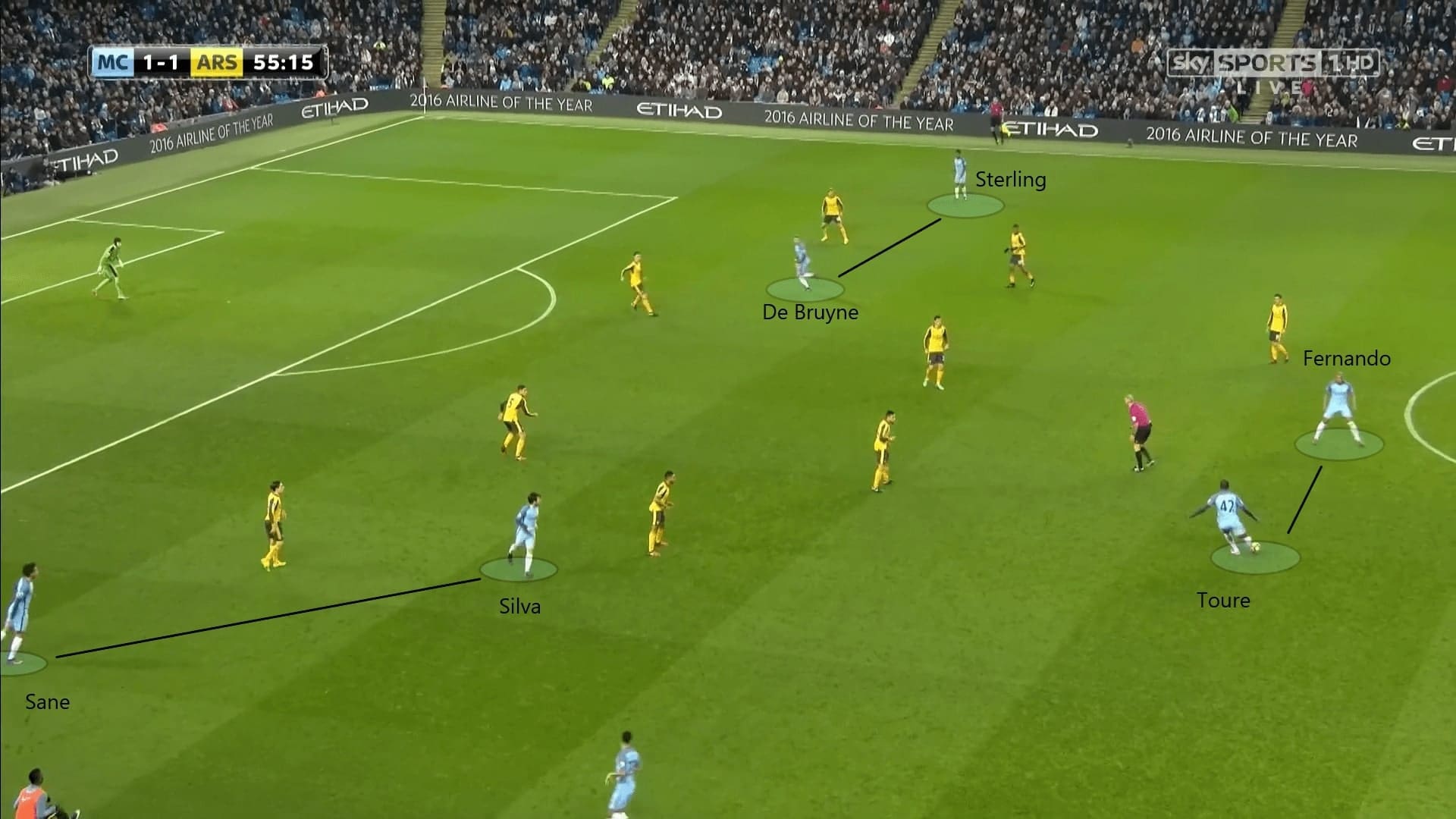
Apart from opening their shape, City also overloaded a flank, as showed in this image. In the outlined area, there were six City players: De Bruyne. Silva, Sterling, Touré, Fernando and Bacary Sagna. They overloaded five yellow shirts. Also, Silva and De Bruyne overloaded Laurent Koscielny. The French player was slightly affected by Silva, hence, moved close to him. It gave De Bruyne the chance to receive the ball from Touré and exploite the space behind the defenders.
This tactic required big efforts of players as their counterparts left their positions. In hopes of covering the midfield after Fernando and Touré went to the right side of the pitch, City left-back Clichy was inverted to the midfield. This prevented City from exposing their centre in transitions if the ball was lost. Also, if City could not progress on their strong side, they could switch the ball to the left flank through the Frenchman, where Sané was providing the width.
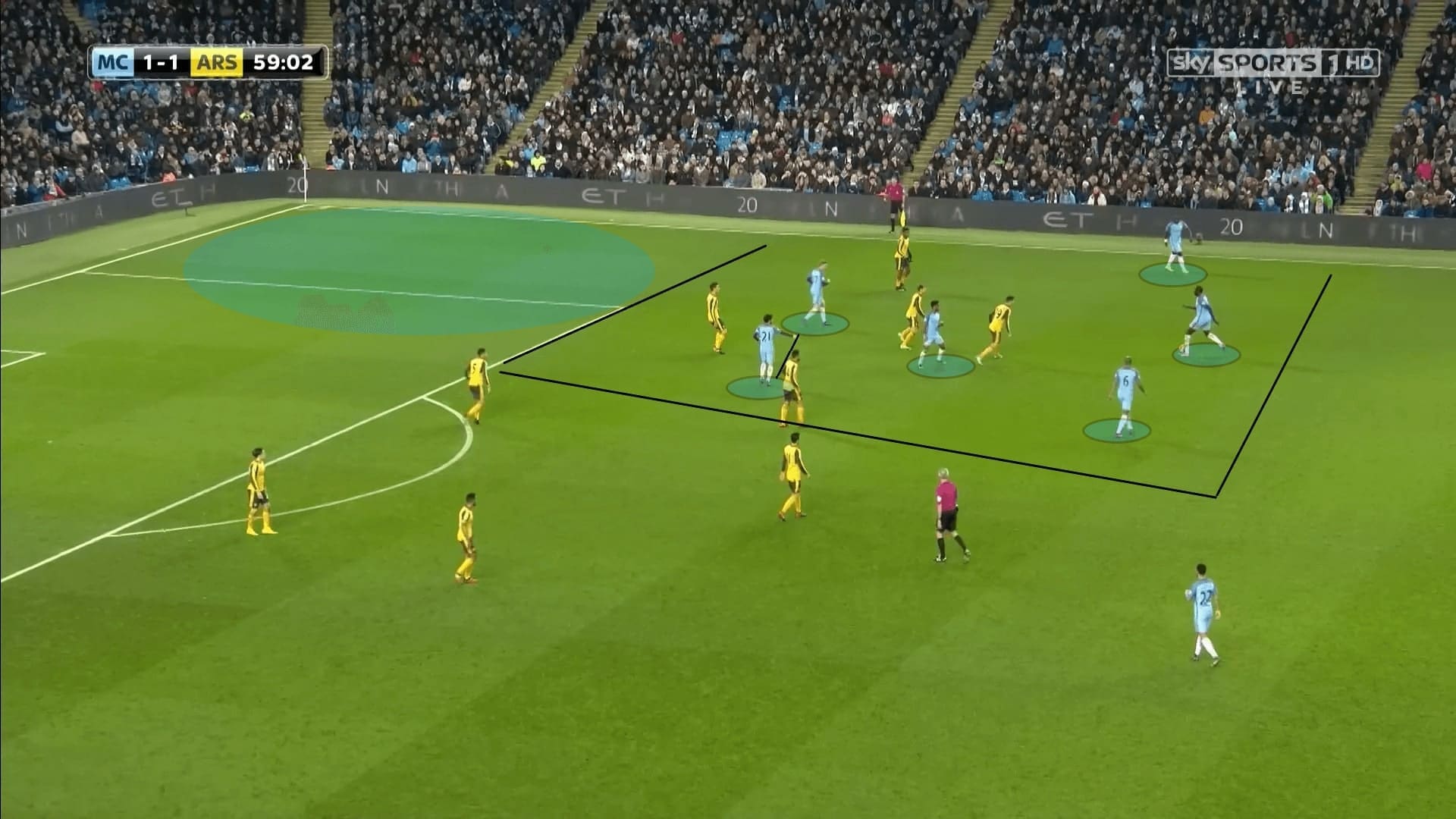
The attack of City was not very smooth, as their players were still adapting to the new system. Also, Arsenal committed numbers, usually, at least eight in their low block. The Gunners had numbers to defend against City. De Bruyne deserves huge credit in the winning goal, as his pass to assist Sterling was extraordinary, this was how the talented players could harm their opponents when normal plays could not break the defence.
Defensive midfielder: Fernando
When speaking of defence, Fernando was the unsung hero of the match. The Brazilian offered quality defensive displays to protect City’s backline. This is a map that includes all 10 interceptions of Fernando in the game. He won seven of them in the highlighted area (zone 10, 11, 12). It showed the Brazilian’s significance in stopping the progression of Arsenal’s attack. He also obtained four successful defensive duels
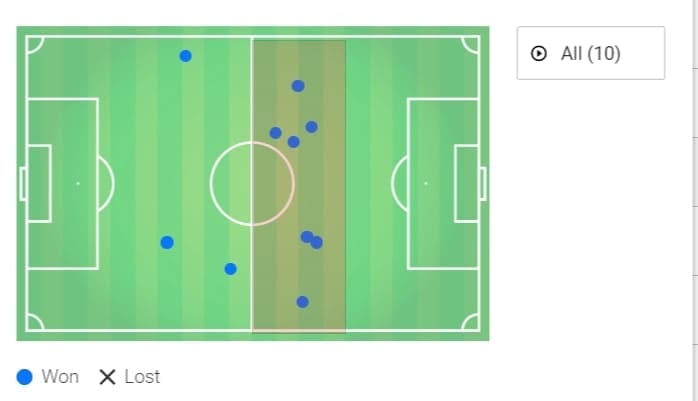
Fernando was important for City to defend transitions in the game. He was encouraged to step out early to provide instant pressure on the ball. Even if he missed his interception the first time, he still chased the opponent and on occasions, helped City regain possession. If he could win the ball high up on the pitch, this could directly transform into a City attack.
In this example, at the very first moment, Otamendi tried to pass the ball to Touré. Nacho Monreal anticipated the pass and intercepted it. Then, he quickly passed it to Xhaka to start a transition. Fernando was fully readied for this pass and he intercepted that pass by arriving from the Swish’s back. This was a vital interception, as, if he missed it, given the exposed City defensive line, they could be in trouble.
Maybe, he could ask Torreira to do Fernando’s job. The Uruguayan also offered relentless efforts in pressing the ball and he has been an aggressive player.
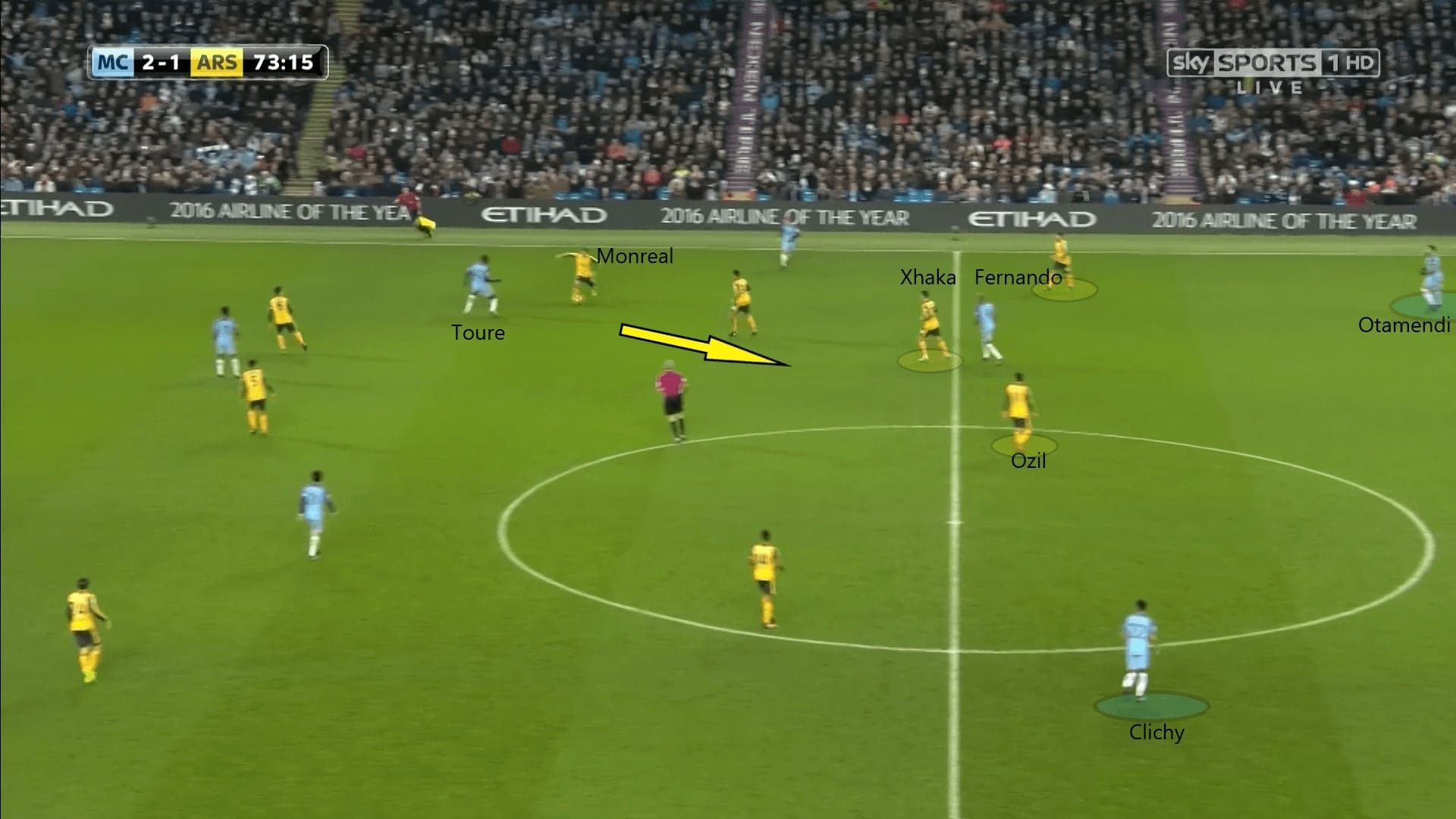
The press of City
City pressed Arsenal to disrupt their build-up. After the equalizer, City pressed more intensively to look for a second goal. Their PPDA went from 4.3 to 5.1 in 60 to 70 minutes of the game. First, we will take a look at the passing graph of Arsenal, as this hinted at some problems of the Gunners.
The top two links both included Gabriel Paulista, with Petr Čech and Héctor Bellerín. It showed he was unable to find the defensive midfielders. Only six of his 62 passes found Xhaka. Also, except for the Theo Walcott goal with an xG of 0.43, after 85 minutes Arsenal’s xG was only 0.22. City did well to prevent their opponents from creating huge chances on most occasions.
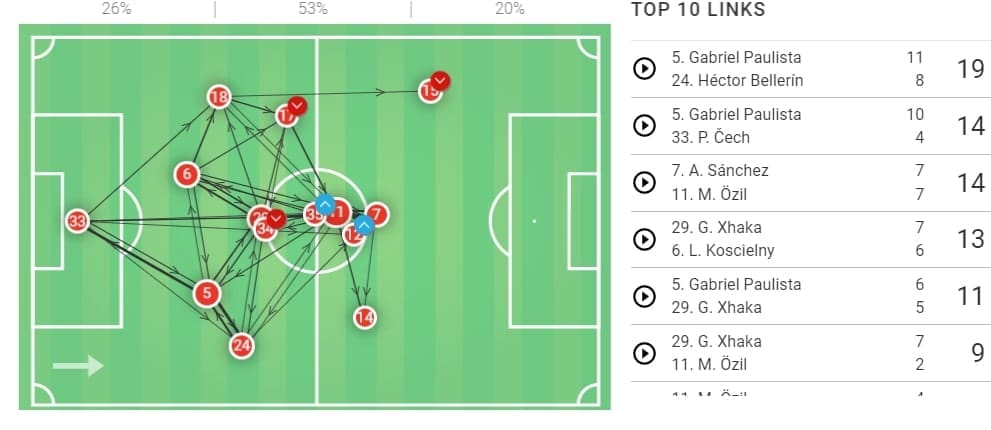
This image illustrated the defence of City. They defended in a 4-4-2 shape. They forced the centre-backs to pass the ball to the full-backs, then limited the options of the full-backs on sides.
In this scene, Paulista just passed the ball to Bellerín, as the passing lane to Mohamed Elneny was shut by De Bruyne. City only left the full-backs free to receive the ball. When the Arsenal full-backs had the ball, they seldom passed the ball to the pivots. Bellerín could not return the ball to Paulista as De Bruyne was around the Brazilian. City liked Arsenal going long as their defenders were well prepared for this. City full-backs liked to step out very early to mark the winger, just like Clichy, who was marking Walcott. They denied almost all options for Arsenal, hence, the Spaniard could only play to the striker who made a diagonal run.
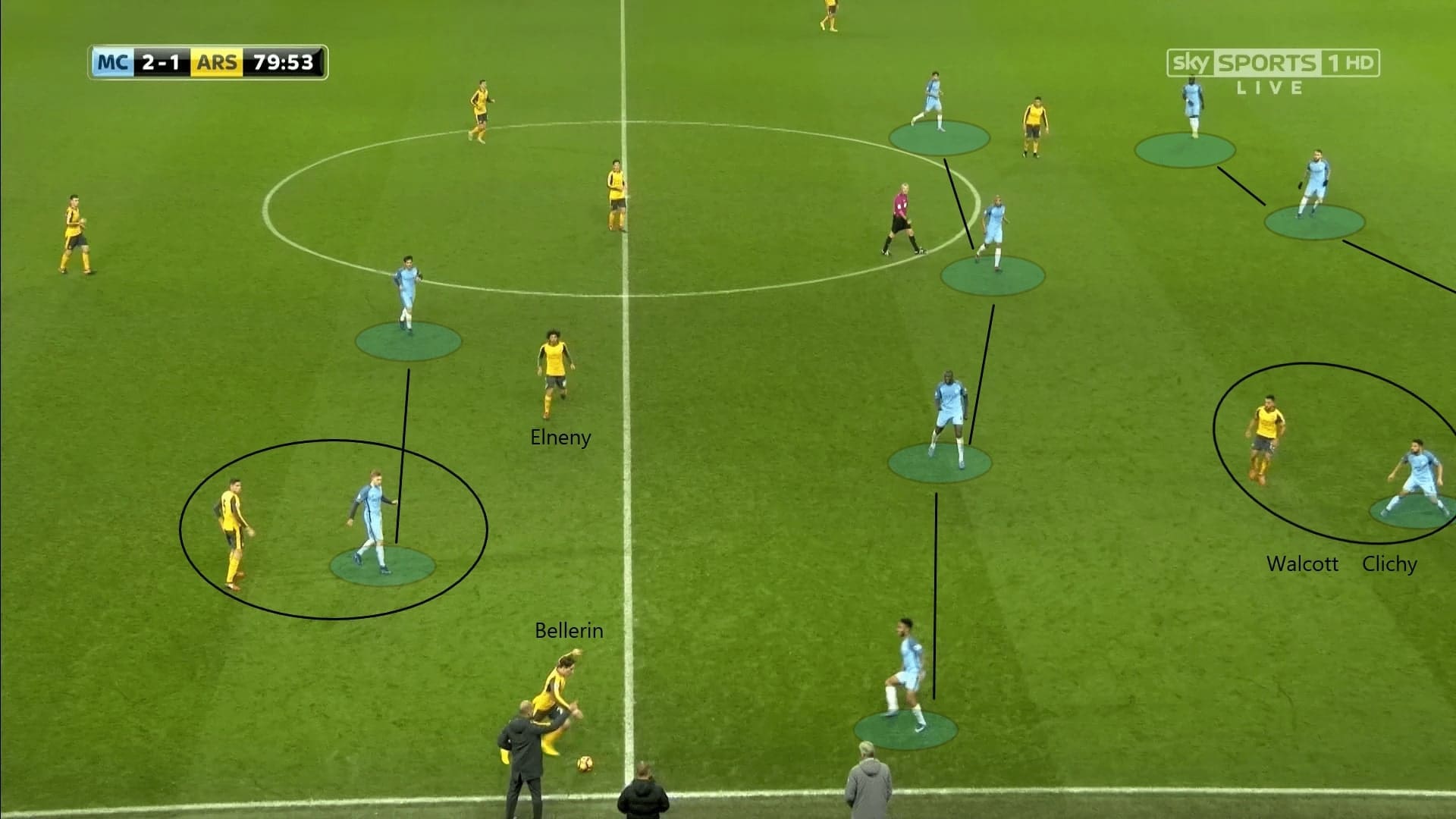
A high defensive line & offside trap
Another feature of Arteta’s City was their high defensive line. Apart from attacking, they held a high line and opened their shape and their players also defended high in their own third to keep Arsenal away from the box. They used the offside trap to stop the opposition from exploiting space between Bravo and the defenders.
We have chosen this example to demonstrate the defence of City. In this scene, when Alex Iwobi tried to cross after dribbling past Pablo Zabaleta, City defenders retreated deep. Also, Fernando and Touré were backed to City’s box.
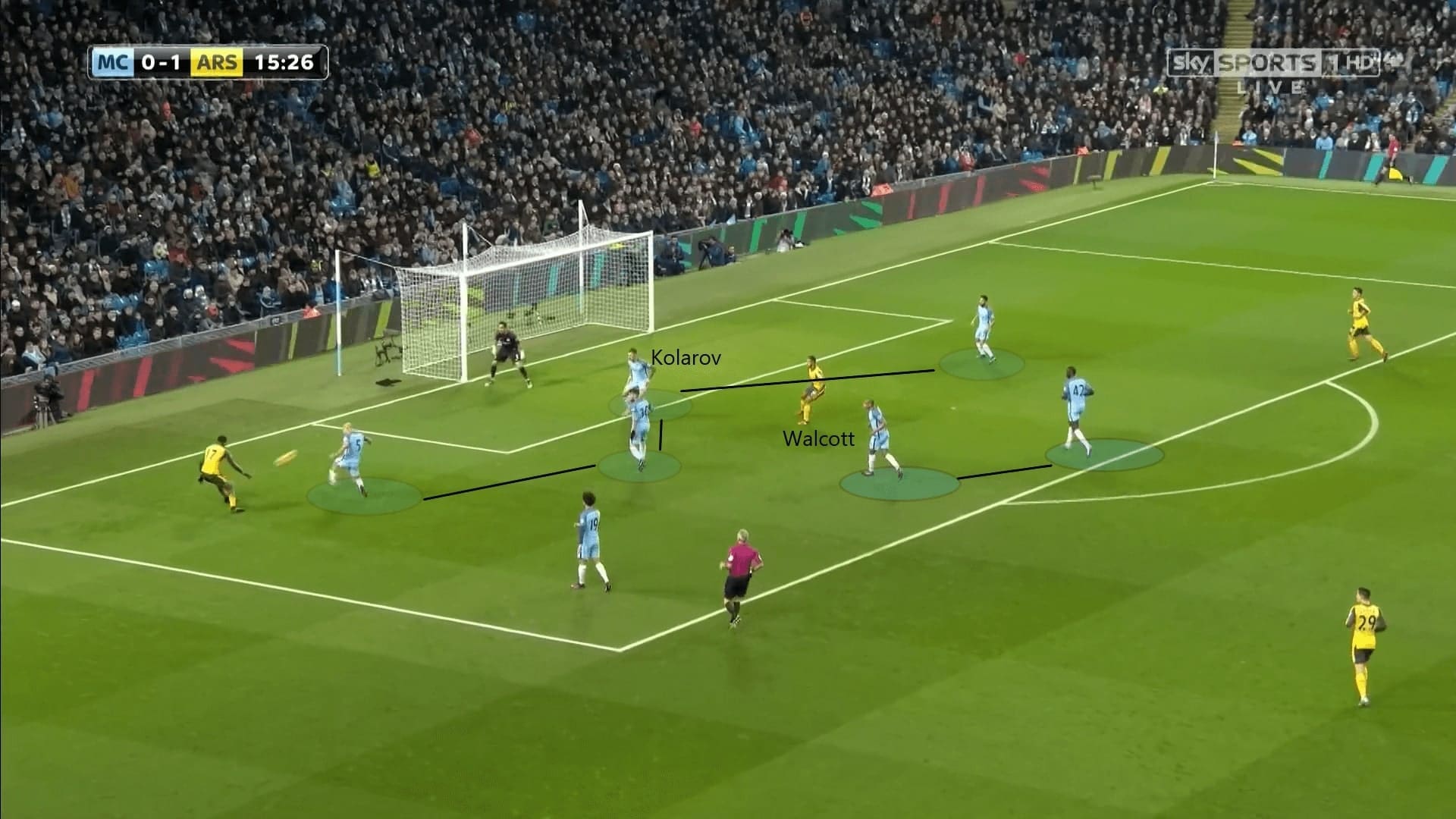
Just six seconds later, after Iwobi failed to find Walcott (he passed the ball to Özil, who was at the far post and could not shoot the first time), Arsenal tried to regroup and attack at the edge of the box. City players all pushed higher from the six-yard box, forming their defensive line at the edge of the area (Zabaleta was slightly below par in this match, he positioned himself too deep). They denied Alexis Sanchez a chance to shoot at the edge of the box when they maintained two layers of defensive lines. The Chilean tried a difficult pass to the centre, and it was intercepted.
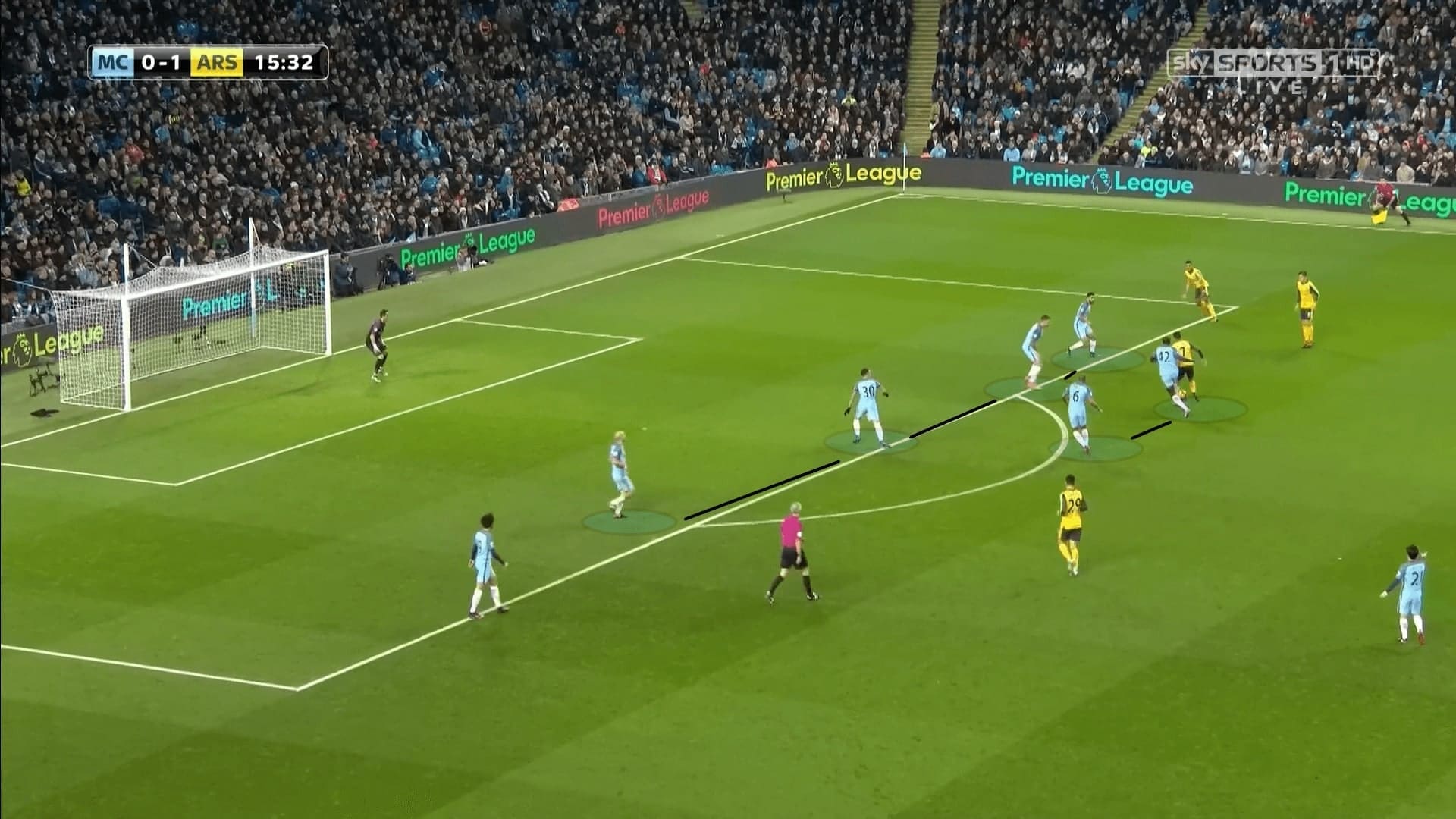
Conclusion
This was the first City game of Arteta in charge – his players ran a lot this match, even until the last kick of the game and were still pressing the ball. Arsenal’s performance was below par, and City made the game difficult to them. When protecting their one-goal lead, he used Kelechi Iheanacho as a substitute to look for counter-attack opportunities instead of playing Stones to defend deep. Another point to make were the changes of Arteta after the break, which were resolute. For example, he swapped the positions of his attackers and used Sagna to replace Zabaleta.
We understand Arteta does not have the exact same players at Arsenal. This match is just a reference to provide some hints of his tactics.

If you love tactical analysis, then you’ll love the digital magazines from totalfootballanalysis.com – a guaranteed 100+ pages of pure tactical analysis covering topics from the Premier League, Serie A, La Liga, Bundesliga and many, many more. Buy your copy of the December issue for just ₤4.99 here




Comments